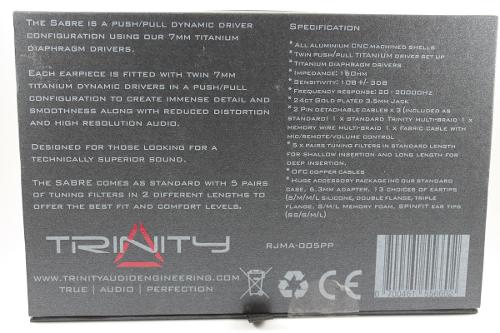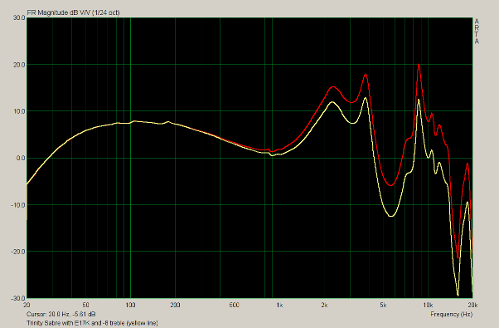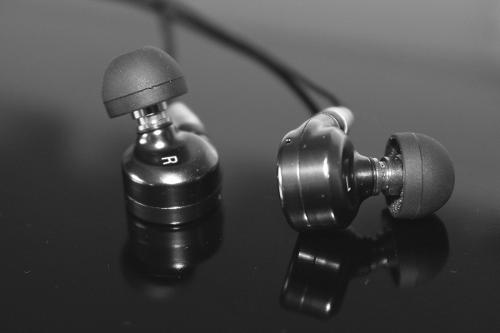
At the time this review was written, the Trinity Sabre was listed for sale on Trinity Audio’s website. Here is a link to their listing of the product:
https://trinity-audio-engineering.myshopify.com/collections/phantom-series/products/trinity-phantom-sabre-push-pull-twin-drive-in-ear-monitor
Introduction
Trinity has established themselves as one of the best earphone manufacturers around when it comes to price and performance. The company is headed up by a guy from the UK named Bob (formerly of Rockjaw). If you’ve been on Head-Fi long enough you probably know him well.
Bob’s vision continues to remain the same. His designs start by asking the Head-Fi community what they want want to see/hear in an earphone. He takes ideas directly from the enthusiasts who participate on the Head-Fi threads, and turns their ideas into fantastic products.
Trinity was launched last year with three earphones in their line-up; the Delta, Techne and Hyperion. After that came the Atlas and Delta V2. I was fortunate to partake in the beta testing process for the Atlas. To this day I still adore Atlas’ fit and sound. They rank very high on my list of preferred monitors.
One thing I’ve learned from my communications with Bob is that once he’s done designing and bringing an earphone to market, the guy doesn’t relax for a second. It’s like he sets a new benchmark for himself with each new product, and tries to beat it with the next earphone he makes. Great design and sound isn’t his only concern. Trinity products come in at prices that can be afforded by the masses. The end result is consumers who feel like they walked away a winner, as well as a camaraderie and loyalty between Trinity and it's target market.
When Bob told me that he had something special coming soon and asked if I would be interested in beta testing another earphone, I didn’t hesitate for a second. The guy called me later that day and unleashed one of the most entertaining “mad scientist” laughs I have ever heard to go along with his distinct British accent. He explained that his brother was big into car audio, and when he showed Bob his “push/pull” subwoofers he just installed in his car, a light bulb was lit in Bob’s brain. If it can be done in car audio and improves overall fidelity, why can’t it be done in earphones as well? This marked the start of the Trinity Phantom Sabre. Although the Sabre isn't the first push/pull hybrid earphone to come to market (that title goes to Audio Technica with their CKR series if I'm not mistaken) it is one of the first drops in what I assume will become a large bucket of earphones with this successful twin driver design.
Push/pull drivers consist of two dynamic drivers that either face each other, or face away from each other. One driver is ran in phase, and the other is ran out of phase. When this is done the cones work off of each other’s momentum. It's similar to two lumberjacks with a crosscut hand saw. When one pushes, the other pulls, making their cuts more efficient, controlled and with less resistance. Apply these physics to audio, and a dynamic driver's cone resistance and air movement is more controlled. The result is a response with less distortion and higher resolution.
Although it was initially promising, the beta unit had some minor flaws and tweaks which needed to be addressed. Feedback on the Sabre beta was shared by a few seasoned Head-Fiers and shared with Trinity. Bob finished his tweaks and the Sabre is now one of the latest releases, and the first in the new Phantom lineup. Let’s go over them with a comprehensive review, shall we?
Disclaimer
I was given an opportunity to review a free sample of the Sabre in exchange for my honest opinion and review. I am in no way affiliated with Trinity audio aside from offering some constructive criticism via beta testing. I would like to take this time to personally thank Bob for the opportunity to experience and review the final version.
My Background
I AM NOT a numbers and graphs audiophile or sound engineer. Personal audio enthusiast? Absolutely! Headphone junkie? Possibly…
There’s something about quality DAPs, DACs, Amplifiers and Earphones that intrigues me. I want to hear any earphone that looks promising, in hopes that I can share my impressions with enthusiasts and help them find the audio product they’re looking for. My Head-Fi profile has a list of audio products ranked from favorite to least favorite. For me, this hobby is more about getting great price to performance ratio from a product, and having a variety of different gear to mix and match. With personal audio gear, we tend to pay a lot of money for minor upgrades. One thing I’ve learned over the last few years is that just because a headphone has a higher price tag, it doesn’t mean that it has superior build and sound quality.
I’m always looking for great audio at a great price. I’m after headphones and IEMs that give me the “WOW” factor. I can appreciate different builds and sound signatures as long as they are solidly built, with ergonomics and sound that is pleasing to my ears. It’s my pleasure to share my experiences with audio products and make recommendations based on gear I have owned and used.
REVIEW

The Sabre comes in a medium size black box with red and gray accents. The front of the box has the product name and a clear plastic coated cutout revealing the Sabre housings.

The back of the box displays specifications, and the benefits of push/pull drivers.
Specifications and Accessories
 Specification:
All aluminium CNC machined shells
Twin push/pull driver set up
Titanium diaphragm drivers
Impedance: 16Ohm
Sensitivity: 108 +/- 3DB
Frequency response: 20 - 20000Hz
24ct Gold plated 3.5mm Jack
Specification:
All aluminium CNC machined shells
Twin push/pull driver set up
Titanium diaphragm drivers
Impedance: 16Ohm
Sensitivity: 108 +/- 3DB
Frequency response: 20 - 20000Hz
24ct Gold plated 3.5mm Jack
 Accessories:
2 Pin detachable cables x 3 (included as standard) 1 x standard Trinity multi-braid 1 x memory wire multi-braid 1 x Fabric cable with mic/remote/volume control
5 x pairs tuning filters in standard length for shallow insertion and long length for deep insertion.
OFC copper cables
Huge accessory package inc our standard case, 6.3mm adapter, 11 choices of eartips (S/M/M/L silicone, double flange, M/L Memory foam, SPINFIT ear tips (SS/S/M/L)
Accessories:
2 Pin detachable cables x 3 (included as standard) 1 x standard Trinity multi-braid 1 x memory wire multi-braid 1 x Fabric cable with mic/remote/volume control
5 x pairs tuning filters in standard length for shallow insertion and long length for deep insertion.
OFC copper cables
Huge accessory package inc our standard case, 6.3mm adapter, 11 choices of eartips (S/M/M/L silicone, double flange, M/L Memory foam, SPINFIT ear tips (SS/S/M/L)
 As with all Trinity models, the accessories package is insanely good. You have everything you need to enjoy your Trinity earphone. I have the utmost confidence just about everyone who purchases a pair will have no problem finding a combination of tips and filters that is ideal for their fit and sound preference.
Housings
As with all Trinity models, the accessories package is insanely good. You have everything you need to enjoy your Trinity earphone. I have the utmost confidence just about everyone who purchases a pair will have no problem finding a combination of tips and filters that is ideal for their fit and sound preference.
Housings
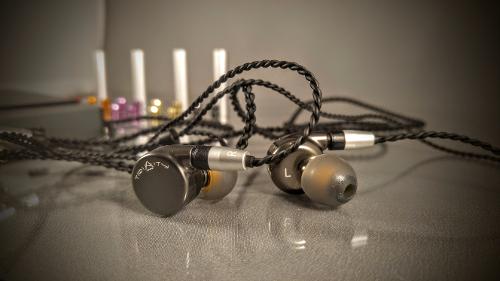
The Sabre housing is a CNC milled and polished aluminum housing. The shape is similar to a stack of dimes. They are lightweight and have a striking appearance. A driver venting hole can be found on the outer back part of the housing.

Sabre uses a two pin connector along with a rubber/plastic fitting that helps make the connection more secure than just the two pins. The Trinity tuning filters operate as the nozzles wihich screw into a threaded fitting on the housings. There are two different lengths for each filter for fitting purpose. More on this in a bit.
Cable, Y-Split, Cable Jack, Strain Reliefs
Sabre comes with three different cables. They are better than average quality and cover the diverse bass tuning preferences of most earphone enthusiasts. All three earphones come with matching two pin jacks and somewhat exclusive fitting to help secure the connection. All three cables come with identical straight 3.5 mm gold plated jacks. A metal jacketing leads to a metal spring strain relief. Y-splits on all three consist of a metal jacketing and a rubber strain relief. A convenient and effective chin/neck slider comes on all three cables and works well with Sabre’s over the ear fit.

The first cable we will go over is the cloth coated phone cable. It's covered in a cloth jacketing and features a three button microphone and remote. The cable is decent but comes with some minor flaws. The cloth cable is prone to kinking if twisted or bent in a way that promotes crimping. If not handled carefully, you will catch yourself getting knots and having to fix them. The remote is all plastic and seems to be on the more generic side things. Although I didn’t have any issues with the remote, I don’t have a lot of confidence in it lasting forever. The chin slider doesn’t snug up as far as I would like due to the mic/remote placement. I don’t mean to be too critical of this cable because overall it’s very decent. To be completely honest I’m not a fan of the increasing instances where new earphones will come with a cloth coated cable, especially ones on the thinner side like this one. In my opinion the negative aspects outweigh the good and I’ve opted for one of the other cables in the package for my pair of Sabre. Even so, it’s nice to see Trinity offer a cable with a microphone and remote. On a positive note, the the cable has very little in terms of spring and memory.
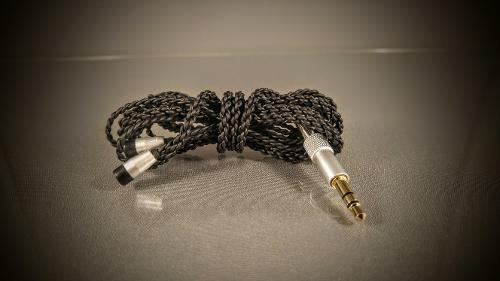
The second cable is a four strand braided black rubber coated cable. If you already own a Trinity earphone, you will be very familiar with this offering. Aside from the two pin connector, it is almost, if not identical to the previous models released by Trinity. I really like this cable a lot. There is very little if any spring or memory, and the soft rubber coating creates a secure fit when looped over my ear. Although it is prone to tangling and knotting, it can be avoided for the most part by handling them in a way that prevents this.

The third cable in the set is almost identical to the second, with the only exception being memory wire near the earpieces. If you are a fan of memory wire this will most likely be the best option out of the bunch for you. Personally, I feel the memory wire hindered my ability to get a fit more than it helped. Your mileage may vary.
Functionality
The three button microphone and remote was tested and works for both Android and Iphone. Functionality was great and I didn’t get any lag or hang ups when using it. When talking to friends and family they reported my voice to come through at a three or four on a scale from one to five. The remote did pick up a considerable amount of wind noise, and also noise from rubbing against my collar. All in all, the remote cable performed reasonably well. Again, the plastic construction raises a small red flag. Handle it with care and you shouldn't have any problems.
Ergonomics, Fit and Microphonics, Isolation

I had no problem getting a secure fit with the Sabre. The over the ear fit works well for my ears. Previous concerns/comments from customers in regards to the Atlas and some other Trinity earphones were that the fit of the Sabre was too shallow. Well, Bob addressed this by offering two different lengths of the same filters (without altering the sound for the most part). That’s right, an entire second set of the same tuning filters in a slightly longer length just to guarantee nobody encounters a fit that’s too shallow. I prefer the shorter filters due to my ear anatomy. When/if your pair of Sabres arrive, make sure to spend the first day or two dialing in a filter you prefer (both for sound and fit). There's lots of options to tinker with. Bob has done just about everything I can think of to make these work for everyone who buys a pair.
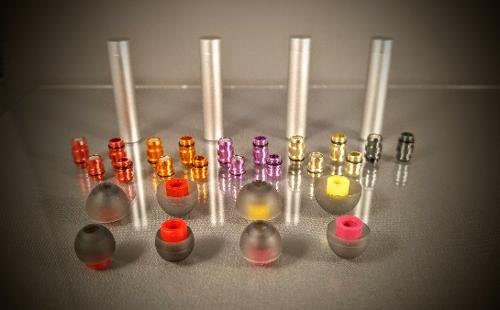
The large tip selection makes getting a seal easy. Trinity is one of the first companies to include Spinfit tips in their accessories package. These are some of the best tips you can get. I am confident many will agree with that statement.
The Sabre’s over ear fit makes microphonics pretty much non existent. Isolation is better than average. These earphones create a vacuum like seal. So much so, there is a mentionable amount of driver flex. Bob guarantees that the flex won’t impact the Sabre sound. If it does, I’m sure Trinity customer service would help with the situation. Lifting the top of your ear with the opposite hand (which opens your ear canal), inserting the earphone, then letting your ear go will allow your inner ear to rest on the earphone tip and create an airtight seal rather than causing pressure build up by jamming them in your ears. This applies not only to the Sabre, but any earphone (especially those with driver flex).
Sound Review
I did my demo with my usual gear. I used an LG-V10 for smartphone use, and either my Shanling H3 or iBasso DX80 DAP/Bushmaster D14 DAC/Amp for high fidelity portable use. For desktop use, I used my Toshiba Satellite Laptop in combination with a ifi micro iDSD playing at 32/192 kHz. I tested them with several other sources as well. I used Google Music in its highest download quality (320 KBPS), and also streamed FLAC via Tidal streaming service. I also used purchased and downloaded tracks in MP3, FLAC, WAV and DSD. I make sure that any gear I test has sufficient playtime before writing a review.
I used my usual same songs for testing gear:
“Limit to your love” by James Blake (bass speed, punch, response)
“Doin’ it Right” by Daft Punk (sub bass)
“Get lucky” by Daft Punk (bass to midrange transition resolution, male vocals)
“Madness” by Muse (soundstage, separation)
“Some nights” by Fun (soundstage and male vocals)
“The soundmaker” by Rodrigo y Gabriela (texture and imaging)
“Bassically” by Tei Shi (bass to midrange resolution, female vocals)
“Skinny Love” performed by Birdie (female vocals, acoustic playback)
“One” by Ed Sheeran (male vocals, acoustic playback)
“Outlands” from the Tron Legacy Soundtrack (symphonic presentation, imaging)
“Sultans of swing” by Dire Straits (detail, separation, balance)
“And Justic for All” by Metallica (driver distortion, treble response, rock playback)
“Ten thousand fists” by Disturbed (driver distortion, treble response, rock playback)
Note: Other tracks were used, but the listed songs were primarily used to assess and break down the gear’s response.
Source Selection
Coming in at 16 Ohms, the Sabre is very easy to drive. They will sound good with just about any low powered source thanks to the diverse range of tuning filters that come in the package. Plug the Sabre into whatever low powered device you plan on using them with (preferably in low gain), then tinker with cables, filters and tips until you have an earphone dialed in perfectly for your listening preferences. On a whole, the leaner (less bassy) filters worked better with warmer sources, while the bassier filters worked well with leaner and cleaner sources.
The Sabre has a fairly high level of resolution, so it will be revealing with poor recordings and low bitrate files. The filter you use will determine how forgiving it is. Once you find the perfect source and filter/tip combination, a high bitrate and high quality recording will help maximize your listening experience with the Sabre.
Sound Signature
 *Measurements of all five filters were taken with my Vibro Veritas coupler and ARTA software. The Veritas is not an industry standard measuring device, but this should give you an ideal of the Sabre tuning as well as how the filters differ
*Measurements of all five filters were taken with my Vibro Veritas coupler and ARTA software. The Veritas is not an industry standard measuring device, but this should give you an ideal of the Sabre tuning as well as how the filters differ
The Sabre has five sets of filters which alters the bass response while doing very little if any measurable difference to the midrange or treble frequencies. I will explain the differences and characteristics with as with most of my reviews, and generalize how the different filters alters the Sabre sound.
When measuring the Sabre filters there was little if any variance between the longer and shorter filters. If anything, the longer filters were a little bit leaner in measurements, but I couldn’t hear an audible difference. There may have been a slight improvement in soundstage, but other than that they are relatively the same. On a whole, I would say the Sabre borders on being considered a V-signature without going far enough to earn that title. It’s an adjustable bass earphone with aggressive midbass and upper midrange tones.
Bass
The Sabre’s filters are nozzles with variances in driver venting holes. With the more linear filters the Sabre has a noticeable roll off at sub bass frequencies and a more noticeable mid bass punch. With the bassier filters sub bass came forward and was perceptually overall more warm in character. I personally preferred the Sabre with the bassier filters (primarily the Orange filters). With the bassier filters I felt the focus was taken off an aggressive upper midrange and midbass, and offered a soundstage depth that made them overall more fun and engaging to listen to. Your mileage may vary.
In terms of response it’s pretty fantastic. Linear filters will make them have more punch than rumble. Bassy filters will give them a nice combination of both. The thing I appreciated the most about the Sabre bass response (regardless of what filter used) was the speed and punch push/pull drivers achieve without sacrificing midrange clarity. During James Blake’s “Limit To Your Love” the bass throbbed at an elite pace, and James’ voice played with great clarity. Bassier filters occasionally struggled with sub bass tones and bordered on being slightly monotone at the lowest frequencies. Despite midbass being forward, there is no “bleed” or distortion to speak of.
Midrange
Lower midrange is slightly forward and continues from where the midbass tones leave off. Male vocals and lower midrange toned instruments will have weight, but they will also sound very responsive and clean.
A slight rolloff takes place from 100 Hz to 1 kHz takes place while maintaining a very high level of resolution. This dip makes things very enjoyable. What I enjoy most about the Sabre is the amount of detail I pick up in the midrange. This is one of the earphones that people will listen to and catch things in their music they haven’t heard before. To my ears, the Sabre midrange isn’t the most natural thing I’ve ever heard, but it’s better than most of the stuff out there in this price range, and the level of detail is pretty phenomenal.
Upper midrange seems a touch aggressive to my ears and borders on being shouty depending on what track I’m listening to. I’m not sure if it’s due to the dip around 1 kHz or the peaks at upper frequency ranges, but there is a slightly dry and colder feel at upper midrange frequencies. This is the main reason I prefer a bassier filter with the Sabre, as it seems to balance out the lower and upper frequencies to my ears and takes the edge off of things. I know other people will hear them differently so I’m curious to hear other people’s impressions on this.
Treble
My Vibro Veritas isn’t an industry standard measuring device, but I’ve measured enough earphones with it to determine radical differences from one earphone to another. With that being said there is rather large roll off at 6-7 kHz, then a fairly sizable lift at 8-10 kHz. Although this tuning takes some of the edge and harshness off where the dip takes place, it sounds a bit unnatural. Vocals finish at upper midrange frequencies with a very forward and almost shouty presence, but most pronunciations of the letters S and T are for the most part relaxed. I think many people will enjoy this tuning because a lot of the edge has been taken off of the sibilant ranges. From what I can hear the lift at around 8-10 kHz saves the Sabre from being overly warm and dark sounding. Overall, some ranges are smooth while others are crisp. You can’t say it’s one thing or the other because there’s elements of both in this frequency range.
Soundstage and Imaging
Soundstage on the Sabre is somewhat intimate. With bassier filters the soundstage has more depth. The somewhat wonky treble presentation is a mixed bag for me. It could be more balanced and maybe a touch more extended. Doing so would allow me to say that they have a nice sense of height. Although this is the case, the fairly high level of resolution prevents me from wanting to give them a bad score in this criteria. I would say that they are average/better than average in terms of soundstage. Combine the somewhat intimate soundstage and high resolution aspects into evaluating the overall imaging, it’s bitter sweet. There’s a nice sense of instrument placement on a stage that isn’t huge
.
Comparisons
Trinity Atlas (Discontinued)
I’ll start this comparison by saying that the Atlas is my favorite Trinity earphone that I’ve heard to this point. Despite others reporting that they got a shallow fit, they fit my ears almost perfectly. I really enjoy their engaging and natural sound. In this comparison I will evaluate them with the orange filters installed on each pair, as they were my preferred filter for both earphones.
Comparing the two, the Atlas seems to be more natural and spacious sounding to my ears. The Sabre has a more warm and forward lower frequency range that is richer, more engaging and more controlled. In terms of treble response, they are perceptually somewhat similar in terms of how forward they project. Although this is the case, the Atlas treble seems just a bit more extended and balanced to my ears.
Build quality is a draw. They are both wonderfully built. I will give an edge to the Sabre for having two pin connectors as opposed to the MMCX connectors of the Atlas. I also give a slight edge to the Sabre’s accessory package thanks to the included Spinfit tips and extra sets of longer tuning filters.
Dunu Titan 3 ($125 to $140 USD on many sites)
The Titan three is known as a “vocal lover’s” earphone, offering a responsive tuning that emphasizes vocals.
Comparing the two, they can be somewhat comparable in tuning with the leaner filters installed on the Sabre. Even still, the Sabre is an all around more relaxed sounding earphone. The Titan 3 reveals more sibilance. Bouncing back and forth, I far prefer the sound of the Sabre with a bassier filter. The Titan 3 may seem to be more clear at first listen, but critical listening revealed more micro details in with the Sabre, primarily in the midrange. Both earphones seem to have a somewhat dry and cold response at upper frequencies, with the Titan 3 being more balanced slightly harsher overall at this range. At the end of this comparison, I couldn’t help it feel like the Titan 3 was a bit hollow sounding in comparison.
Build quality is a draw. Both earphones have all metal housings and are well constructed. Fit is also a draw. The Trinity accessories package runs circles around the Titan 3 which isn’t an easy feat, considering the Titan 3 accessories package is really decent.
Conclusion
The Sabre has a lot of really unique and cool aspects about it. The Tuning is really engaging, and I enjoyed the heck out of the bass performance and overall sound (especially with the orange filters installed). The accessories package is insanely good for the asking price. I honestly have no idea how Bob makes money off of these earphones with all the goodies that are included. The accessories package is so good, I can’t imagine very many people being able to say that they couldn’t find a combination that matches their fit and sound preference.
The Sabre isn’t the most natural sounding earphone I’ve ever listened to, but the push/pull driver setup brings some very unique and special traits to the table, primarily the fast response and ability to reveal micro details at an elite level.
When rating this product, I have to take all criteria into account. The Sabre gets an easy five stars for accessories and fit, three and a half stars for sound, four stars for price to performance, and I have to deduct a half star for driver flex. All in all I give the Sabre four stars. They are a very respectable earphone for their price.

Thanks for reading and happy listening!




